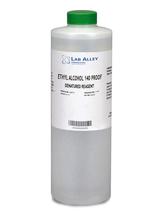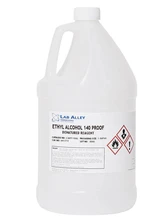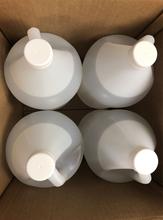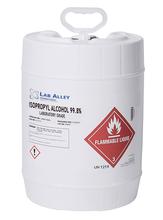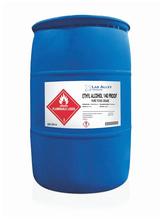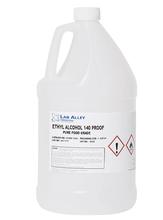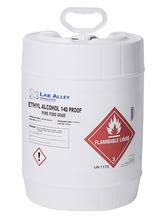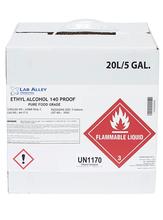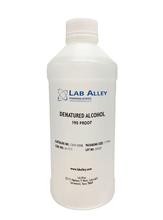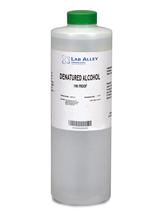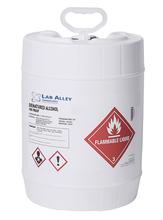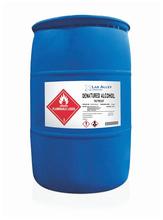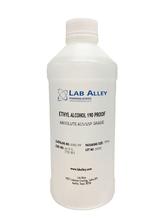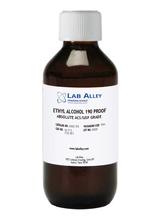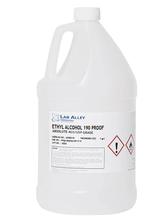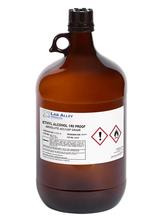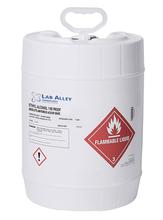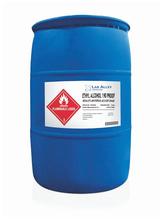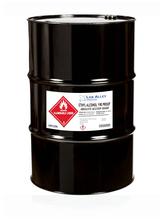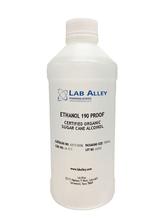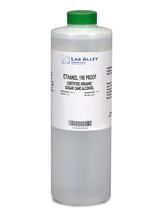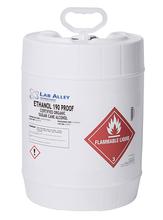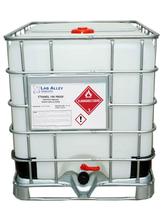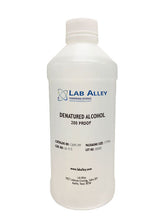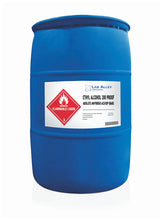Buy Ethanol Online | Food Grade | 100%, 95%, 70% | FCC & USP Grade | Formula C2H5OH | Antiviral Ingredient For Hand Sanitizers, Disinfection Sprays & Household Cleaners | Solvent For Herbal & Botanical Extracts | 200, 190 & 140 Proof Alcohol
70% Denatured Ethanol In Stock | 140 Proof Alcohol For Sale Online
Pure 70% Food Grade Ethanol In Stock | 140 Proof | FCC, ACS & USP Grade | Non-Denatured Alcohol | Ethyl Alcohol | For Sale Online
95% Denatured Ethanol In Stock | 190 Proof Alcohol For Sale Online
Pure 95% Food Grade Ethanol In Stock | 190 Proof | Non-Denatured Alcohol | Ethyl Alcohol | FCC, ACS & USP Grade | For Sale Online | Learn How To Dilute Here >
Certified Organic Cane Alcohol (190 Proof) For Botanical Extract And Hand Sanitizer Makers
100% Denatured Ethanol (Alcohol) | Antiviral Ethyl Alcohol In Stock
100% Non-Denatured Ethanol | Pure Food Grade Alcohol In Stock | USP & FCC Grade | 200 Proof | Antiviral Ethyl Alcohol
Buy Ethanol (C2H5OH) In Bulk Online Here Or By Phone: 512-668-9918
If you have questions about ordering ethanol (ethyl alcohol), antiviral alcohol or laboratory supplies online here at LabAlley.com or would like to place an order, call 512-668-9918 or email customerservice@laballey.com to talk with an Ethanol Specialist. Buy ingredients for safe recipes for DIY homemade hand sanitizers here. Lab Alley sells high proof alcohol (200, 190 & 140 Proof Ethanol) in small and bulk size quantities.
About Organic Cane Alcohol Sold Online At LabAlley.com
Sugar cane alcohol sold online at LabAlley.com has a neutral taste and smell. It is a fermented and distilled liquid that is made from sugar cane juice. The sugar cane plant is a tall perennial grass that is native to Southeast Asia and the South Pacific. Sugar cane thrives in warm and humid tropical climates. Ethanol (sugar cane alcohol) is made by crushing cane stalks by using an extractor/expeller which extracts sugar-rich cane juice. The cane juice is fermented with yeast to produce ethanol. Ethanol from sugar cane is manufactured by fermenting cane sugar or using fresh sugar cane juice. Get more information on sugarcane ethanol production here.
Video Testimonial From A Customer That Ordered Organic Sugarcane Alcohol From Lab Alley
YouTube Video Testimonial Titled "Reasons Lab Alley Is The Perfect Choice"
Uploaded By Lab Alley On December 7, 2021
When Shawn Dunn from shroomworks needed high-quality organic cane alcohol quickly, he ordered safe and pure organic food grade alcohol online at Lab Alley.
Lab Alley delivered on time and also provided excellent customer service. Shawn ordered the Lab Alley Brand of Ethanol 190 Proof (95%) Certified Organic Sugarcane Alcohol (Food Grade) online, here.
Shawn Dunn, and his brother Justin, founded the company called shroomworks in Los Angeles, California in 2018. Their small business makes mushroom wellness supplements, functional mushroom extracts and tinctures using Lab Alley Brand organic ethanol.
Their mission is to spread the amazing health benefits of functional mushrooms by crafting products that are effective, approachable, and easy to use. Functional mushrooms have a health benefit beyond providing nutrition.
Tincture makers, like Shawn Dunn, order food grade alcohol from Lab Alley to use as an effective solvent for plant extraction, because it is safe.
Certified organic food grade ethanol is sold in 1 gallon bottles at Lab Alley.
Pure 200 Proof Non-Denatured Food Grade Ethanol is acknowledged as a food safe ingredient because it has no additives. This is the highest proof ethyl alcohol sold to tincture and extract makers by Lab Alley. Lab Alley's loyal customers order food grade ethanol to use as an effective solvent for plant extraction, because it is safe.
Everything ingredient in their products is 100% organic and the tinctures that shroomworks produces contain no chemical or artificial ingredients. The Dunn brothers believe that real healing products need to be made from real ingredients that can be found in nature. These ambitious men bring mushrooms to the world in the most fun, delicious, and impactful way.
Organic Ethanol (ethyl alcohol) sold by Lab Alley is regulated by the FDA as a food ingredient. The Lab Alley Brands of Organic Alcohol, included Certified Organic Cane Alcohol (190 Proof), are simple alcohols with the chemical formula C₂H₆O.
Mushroom tincture makers use high-proof (190 proof) organic alcohols, made from corn and sugarcane, that are commercially available at Lab Alley, because they are very safe for consumption in tiny amounts. Tincture makers usually use at least 25% organic ethanol sourced from Lab Alley in their extracts.
Who Uses Cane Alcohol?
American businesses, growers, food processors, botanical extract suppliers, medicinal plant processors, flavorings manufacturers, tincture manufacturers and marketers of herbs and herbal products purchase organic cane alcohol online at LabAlley.com to use as an extraction solvent.
190 proof organic sugar cane alcohol sold online at LabAlley.com is used in various food applications, as a preservative and as an aid in vinegar production.
Organic cane alcohol is ordered online at LabAlley.com by companies that manufacture plant-based medicines, cosmetics, essential oils, perfumes, personal care products, dietary and herbal supplements, natural products, foods and non-prescription drugs.
Conscientiousness plant processing facilities in the U.S. often use organic cane alcohol to extract bioactive compounds from medicinal plants. The botanical extracts may be diluted with organic MCT oil or coconut oil purchased online at LabAlley.com to formulate natural substances and organic personal care products. Another popular oil extraction solvent ordered online is food grade alcohol (ethanol).
Sugar cane alcohol can be used to make distilled spirits such as vodka, bitters and liqueurs. It is used to make rum and caçhaca. Sugarcane spirit is a base spirit is used in industrial alcohol production and fermented beverage production. Buy organic cane alcohol here.
Hand Sanitizer Tool Kit From USP Demand for alcohol-based hand sanitizers from traditional large-scale commercial manufacturing has surpassed its supply and some of the ingredients traditionally used in hand sanitizers are in shortage. In response to this, the U.S. Food and Drug Administration (FDA), the Centers for Disease Control and Prevention (CDC), the World Health Organization (WHO) and other public health organizations have developed important guidance for compounding hand sanitizers, and for the preparation of hand sanitizers by manufacturers and other facilities, such as distilleries. USP has also issued recommendations developed by its Compounding Expert Committee for the compounding of hand sanitizers, including different formulations and utilizing alternative ingredients.
Information For Compounders
WHO
The WHO provides a practical guide for use at the pharmacy bench during the actual preparation of the hand sanitizer formulations. Information in the guide includes materials required for small volume production and 10-liter preparations. Formulations include starting material of ethanol 96% for final product concentration of ethanol 80% (v/v) or starting material of isopropyl alcohol 99.8% for final product concentration of isopropyl alcohol 75% (v/v).
FDA
The FDA issued “Policy for Temporary Compounding of Certain Alcohol-Based Hand Sanitizer Products During the Public Health Emergency” Immediately in Effect Guidance for Industry.” TThe guidance explains that FDA does not intend to take action against compounders that prepare alcohol-based hand sanitizers for consumer use and for use as health care personnel hand rubs for the duration of the public health emergency provided certain circumstances are present. The circumstances include the following:
The hand sanitizer is compounded according to the following formula consistent with WHO recommendations:
- alcohol (ethanol) (80%, v/v) in an aqueous solution denatured according to Alcohol and Tobacco Tax and Trade Bureau regulations in 27 CFR part 20; or isopropyl alcohol (75%, v/v) in an aqueous solution
- alcohol (ethanol) (if derived from synthetic processes, is used only if it meets USP or FCC grade), that is not less than 94.9% ethanol by volume;
- glycerol (1.45%, v/v), glycerin (glycerol) USP or FCC (also known as “food grade”)
- hydrogen peroxide (0.125%, v/v), USP Hydrogen Peroxide Concentrate or USP Hydrogen Peroxide Topical Solution
- sterile water (e.g., by boiling, distillation or other process that results in water that meets the specifications for Purified Water USP).
The alcohol (ethanol) is denatured either by the alcohol producer or at the point of production of the finished hand sanitizer product. See Alcohol and Tobacco Tax and Trade Bureau regulations in 27 CFR part 20 and 21. The hand sanitizer is prepared under conditions routinely used by the compounder to compound similar nonsterile drugs (USP General Chapter <795>).
NASPA
The National Alliance of State Pharmacy Associations (NASPA) is providing information from the States related to compounding hand sanitizers.
- Download Ethanol Safety Data Sheets (SDS/MSDS) Here
- Buy Ethanol Online At LabAlley.com/Collections/Ethanol
- Ethanol Density: 789 kg/m³
- Ethanol Formula: C2H5OH
- Ethanol Solubility: Soluble In Water, Hexane, Chloroform, Water, Hexane, Diethyl Ether, Ethyl Acetate, Sodium Hydroxide (NaOH), Kerosene, Gasoline (Petrol), Carbon Tetrachloride (Tetrachloromethane/CCl4) And Heptane
- Solvent Miscibility Table
- Ethanol Miscibility: Completely Miscible
- Ethanol Structure: AKA Ethyl Alcohol, Abbreviated As EtOH, Ethanol Has One Methyl (-CH3) Group, One Methylene (-CH2-) Group And One Hydroxyl (-OH) Group
- Ethanol Boiling Point: 173.1°F (78.37°C)
- Ethanol Melting Point: -173.5°F (-114.1°C)
- Ethanol CAS Registry Number: 64-17-5
- Molar Mass: 46.07 g/mol
- Boiling Point: 173.1°F (78.37°C)
- IUPAC ID: Ethanol
- Ethanol ChemSpider ID: 682
- Ethanol PubChem CID: 702
- Ethanol Chemical Formula: C2H5OH | Can Be Written As CH3CH2OH
- Pka: Ethanol's pKa Value Is About 15.9
- Wikipedia Description Of Ethanol: Ethanol is a chemical compound and a simple alcohol. It is a volatile, flammable, colorless liquid with a slight characteristic odor.
- PubChem Description Of Ethanol: Ethanol is a clear, colorless liquid rapidly absorbed from the gastrointestinal tract and distributed throughout the body. It has bactericidal activity and is used often as a topical disinfectant. It is widely used as a solvent and preservative in pharmaceutical preparations as well as serving as the primary ingredient in alcoholic beverages. Indeed, ethanol has widespread use as a solvent of substances intended for human contact or consumption, including scents, flavorings, colorings, and medicines.
Can't Get Your Hands On Hand Sanitizer? Make Your Own
By Megan Cerullo, April 3, 2020
Hand sanitizer is flying off store shelves in the U.S. as individuals and businesses stock up on supplies to protect them against virus infection.
Public health experts advise that cleaning your hands with either soap and water, or an alcohol-based solution, is one of the best ways to avoid infection — guidance the public appears to be heeding. Consumer demand for hand sanitizers has soared 1,400% in recent weeks, according to retail industry data. Some sellers are limiting the number of containers customers can buy per visit, while others are jacking up their prices in stores and online.
Thankfully, experts have a feasible solution for consumers who can't find the personal disinfectant in stores: Make your own.
"Homemade hand sanitizers are just as effective as what you buy as long as you use the right percentage of alcohol," CBS News contributor Dr. David Agus told CBS MoneyWatch. "This is a good way to get around people price-gouging for Purell."
Do-it-yourself sanitizers must contain at least 60% alcohol, by volume, to work, Dr. Agus said. Isopropyl alcohol (better known as rubbing alcohol) or ethanol are both suitable varieties, experts told CBS MoneyWatch. Other doctors recommend using at least 90% alcohol to ensure the hand-made sanitizer is strong enough and to avoid any risk of diluting the compound if other ingredients are added, such as aloe vera.
"If you make it well, it's about as effective as using soap and water," said Dr. Stephen Morse, a professor of epidemiology at Columbia University in New York. "We know it works — just make sure it has enough alcohol in it."
Adding aloe vera will make it easier to apply to the skin and add thickness. And stirring in a few drops of an essential oil, such as lavender, will give the mixture a pleasing fragrance — so users don't smell like rubbing alcohol around the home or office. Here's a list of required ingredients to make your own hand sanitizer:
- 2/3 cup of rubbing alcohol
- 1/3 cup aloe vera gel
- 5-10 drops of essential oil (optional)
- Mixing bowl
- Spoon
- Funnel
- Two-ounce spray bottle or liquid soap container
- Masking tape and pen or marker for labeling the container (or adhesive labels)
Directions: Pour the alcohol and aloe vera in a bowl and stir until blended. Add several drops of essential oil and stir to help mask the smell of alcohol. Use the funnel to pour the eight ounce mixture into containers, then affix the strips of marked masking tape (or adhesive labels) to identify the bottles' contents.
Hand sanitizer doesn't kill all viruses. Dr. Agus explained. The virus is protected by a shell, called an "envelope glycoprotein," which the alcohol scrambles. "When you take away the protective part of the virus, it dies pretty quickly," he said. While soap and water is also effective against the virus, hand sanitizer is often more convenient. "We are a lazy society — no one wants to sit around for 20 seconds and wash their hands," Dr. Agus said.
Plus, sinks are usually located in bathrooms, requiring users to touch a doorknob — and risk becoming reinfected — to exit. Eventually, the necessary ingredients to make hand sanitizer could end up in short supply. Until then, "Quick-fix sanitizers do work," according to Dr. Agus.
Dr. Sanjay Maggirwar, professor of microbiology at George Washington University, said homemade sanitizers can last weeks if they are properly stored in closed bottles.
Information On Hand Sanitizer Ingredients From Wikipedia
Hand sanitizer is a liquid, gel, or foam generally used to decrease infectious agents on the hands. In most settings, hand washing with soap and water is generally preferred. Hand sanitizer is less effective at killing certain kinds of germs, such as norovirus and Clostridium difficile and unlike soap and water, it cannot remove harmful chemicals. People may incorrectly wiped off hand sanitizer before it has dried, and some are less effective because their alcohol concentrations are too low.
In most healthcare settings alcohol-based hand sanitizers are preferable to hand washing with soap and water. Reasons include it being better tolerated and more effective. Hand washing with soap and water; however, should be carried out if contamination can be seen, or following the use of the toilet. The general use of non-alcohol-based hand sanitizers has no recommendations.
Alcohol-based versions typically contain some combination of isopropyl alcohol, ethanol (ethyl alcohol), or n-propanol, with versions containing 60% to 95% alcohol the most effective. Care should be taken as they are flammable. Alcohol-based hand sanitizer works against a wide variety of microorganisms but not spores. Compounds such as glycerol may be added to prevent drying of the skin. Some versions contain fragrances; however, these are discouraged due to the risk of allergic reactions. Non-alcohol based versions typically contain benzalkonium chloride or triclosan; but are less effective than alcohol-based ones.
Alcohol has been used as an antiseptic at least as early as 1363 with evidence to support its use becoming available in the late 1800s. Alcohol-based hand sanitizer has been commonly used in Europe since at least the 1980s. The alcohol-based version is on the World Health Organization's List of Essential Medicines, the safest and most effective medicines needed in a health system.
The Clean Hands campaign by the US Centers for Disease Control and Prevention (CDC) instructs the public in hand washing. Alcohol-based hand sanitizer is recommended only if soap and water are not available.
When using an alcohol-based hand sanitizer:
- Apply product to the palm of one hand.
- Rub hands together.
- Rub the product over all surfaces of hands and fingers until hands are dry.
- Do not go near flame or gas burner or any burning object during applying hand sanitizer.
- The current evidence for the effectiveness of school hand hygiene interventions is of poor quality.
Alcohol-based hand sanitizers may not be effective if the hands are greasy or visibly soiled. In hospitals, the hands of healthcare workers are often contaminated with pathogens, but rarely soiled or greasy. In community settings, on the other hand, grease and soiling is common from activities such as handling food, playing sports, gardening, and being active outdoors. Similarly, contaminants like heavy metals and pesticides (generally found outdoors) cannot be removed by hand sanitizers. Hand sanitizers may also be swallowed by children, especially if brightly-coloured.
Some commercially-available hand sanitizers (and online recipes for homemade rubs) have alcohol concentrations that are too low. This makes them less effective at killing germs. Poorer people in developed countries and people in developing countries may find it harder to get a hand sanitizer with an effective alcohol concentration. Fraudulent labelling of alcohol concentrations has been a problem in Guyana.
Hand sanitizers were first introduced in 1966 in medical settings such as hospitals and healthcare facilities. The product was popularized in the early 1990s.
Alcohol-based hand sanitizer is more convenient compared to hand washing with soap and water in most situations in the healthcare setting. Among healthcare workers, it is generally more effective for hand antisepsis, and better tolerated than soap and water. Hand washing should still be carried out if contamination can be seen or following the use of the toilet.
Hand sanitizer that contains at least 60% alcohol or contains a "persistent antiseptic" should be used. Alcohol rubs kill many different kinds of bacteria, including antibiotic resistant bacteria and TB bacteria. They also kill many kinds of viruses, including the flu virus, the common cold virus, and HIV.
90% alcohol rubs are more effective against viruses than most other forms of hand washing. Isopropyl alcohol will kill 99.99 % or more of all non-spore forming bacteria in less than 30 seconds, both in the laboratory and on human skin.
The alcohol in hand sanitizers may not have the 10–15 seconds exposure time required to denature proteins and lyse cells in too low quantities (0.3 ml) or concentrations (below 60%). In environments with high lipids or protein waste (such as food processing), the use of alcohol hand rubs alone may not be sufficient to ensure proper hand hygiene.
For health care settings like hospitals and clinics, optimum alcohol concentration to kill bacteria is 70% to 95%. Products with alcohol concentrations as low as 40% are available in American stores, according to researchers at East Tennessee State University.
Alcohol rub sanitizers kill most bacteria, and fungi, and stop some viruses. Alcohol rub sanitizers containing at least 70% alcohol (mainly ethyl alcohol) kill 99.9% of the bacteria on hands 30 seconds after application and 99.99% to 99.999% in one minute.
For health care, optimal disinfection requires attention to all exposed surfaces such as around the fingernails, between the fingers, on the back of the thumb, and around the wrist. Hand alcohol should be thoroughly rubbed into the hands and on the lower forearm for a duration of at least 30 seconds and then allowed to air dry.
Use of alcohol-based hand gels dries skin less, leaving more moisture in the epidermis, than hand washing with antiseptic/antimicrobial soap and water.
There are certain situations during which hand washing with soap and water are preferred over hand sanitizer, these include: eliminating bacterial spores of Clostridioides difficile, parasites such as Cryptosporidium, and certain viruses like norovirus depending on the concentration of alcohol in the sanitizer (95% alcohol was seen to be most effective in eliminating most viruses). In addition, if hands are contaminated with fluids or other visible contaminates, hand washing is preferred as well as after using the toilet and if discomfort develops from the residue of alcohol sanitizer use. Furthermore, CDC states hand sanitizers are not effective in removing chemicals such as pesticides.
Fire
Alcohol gel can catch fire, producing a translucent blue flame. This is due to the flammable alcohol in the gel. Some hand sanitizer gels may not produce this effect due to a high concentration of water or moisturizing agents. There have been some rare instances where alcohol has been implicated in starting fires in the operating room, including a case where alcohol used as an antiseptic pooled under the surgical drapes in an operating room and caused a fire when a cautery instrument was used. Alcohol gel was not implicated.
To minimize the risk of fire, alcohol rub users are instructed to rub their hands until dry, which indicates that the flammable alcohol has evaporated. Igniting alcohol hand rub while using it is rare, but the need for this is underlined by one case of a health care worker using hand rub, removing a polyester isolation gown, and then touching a metal door while her hands were still wet; static electricity produced an audible spark and ignited the hand gel. Fire departments suggest refills for the alcohol-based hand sanitizers can be stored with cleaning supplies away from heat sources or open flames.
Skin
Research shows that alcohol hand sanitizers do not pose any risk by eliminating beneficial microorganisms that are naturally present on the skin. The body quickly replenishes the beneficial microbes on the hands, often moving them in from just up the arms where there are fewer harmful microorganisms.
However, alcohol may strip the skin of the outer layer of oil, which may have negative effects on barrier function of the skin. A study also shows that disinfecting hands with an antimicrobial detergent results in a greater barrier disruption of skin compared to alcohol solutions, suggesting an increased loss of skin lipids.
Ingestion
In the United States, the U.S. Food and Drug Administration (FDA) controls antimicrobial handsoaps and sanitizers as over-the-counter drugs (OTC) because they are intended for topical anti-microbial use to prevent disease in humans.
The FDA requires strict labeling which informs consumers on proper use of this OTC drug and dangers to avoid, including warning adults not to ingest, not to use in the eyes, to keep out of the reach of children, and to allow use by children only under adult supervision. According to the American Association of Poison Control Centers, there were nearly 12,000 cases of hand sanitizer ingestion in 2006. If ingested, alcohol-based hand sanitizers can cause alcohol poisoning in small children. However, the U.S. Centers for Disease Control recommends using hand sanitizer with children to promote good hygiene, under supervision, and furthermore recommends parents pack hand sanitizer for their children when traveling, to avoid their contracting disease from dirty hands.
There have been reported incidents of people drinking the gel in prisons and hospitals, where alcohol consumption is not allowed, to become intoxicated leading to its withdrawal from some establishments.
On April 30, 2015, the FDA announced that they were requesting more scientific data based on the safety of hand sanitizer. Emerging science suggests that for at least some health care antiseptic active ingredients, systemic exposure (full body exposure as shown by detection of antiseptic ingredients in the blood or urine) is higher than previously thought, and existing data raise potential concerns about the effects of repeated daily human exposure to some antiseptic active ingredients. This would include hand antiseptic products containing alcohol and triclosan.
Hands must be disinfected before any surgical procedure by hand washing with mild soap and then hand-rubbing with a sanitizer. Surgical disinfection requires a larger dose of the hand-rub and a longer rubbing time than is ordinarily used. It is usually done in two applications according to specific hand-rubbing techniques, EN1499 (hygienic handwash), and EN 1500 (hygienic hand disinfection) to ensure that antiseptic is applied everywhere on the surface of the hand.
Some hand sanitizer products use agents other than alcohol to kill microorganisms, such as povidone-iodine, benzalkonium chloride or triclosan. The World Health Organization (WHO) and the CDC recommends "persistent" antiseptics for hand sanitizers. Persistent activity is defined as the prolonged or extended antimicrobial activity that prevents or inhibits the proliferation or survival of microorganisms after application of the product. This activity may be demonstrated by sampling a site several minutes or hours after application and demonstrating bacterial antimicrobial effectiveness when compared with a baseline level. This property also has been referred to as "residual activity." Both substantive and nonsubstantive active ingredients can show a persistent effect if they substantially lower the number of bacteria during the wash period.
Laboratory studies have shown lingering benzalkonium chloride may be associated with antibiotic resistance in MRSA. Tolerance to alcohol sanitizers may develop in fecal bacteria. Where alcohol sanitizers utilize 62%, or higher, alcohol by weight, only 0.1 to 0.13% of benzalkonium chloride by weight provides equivalent antimicrobial effectiveness.
Triclosan has been shown to accumulate in biosolids in the environment, one of the top seven organic contaminants in waste water according to the National Toxicology Program Triclosan leads to various problems with natural biological systems, and triclosan, when combined with chlorine e.g. from tap water, produces dioxins, a probable carcinogen in humans. However, 90–98% of triclosan in waste water biodegrades by both photolytic or natural biological processes or is removed due to sorption in waste water treatment plants. Numerous studies show that only very small traces are detectable in the effluent water that reaches rivers.
A series of studies show that photodegradation of triclosan produced 2,4-dichlorophenol and 2,8-dichlorodibenzo-p-dioxin (2,8-DCDD). The 2,4-dichlorophenol itself is known to be biodegradable as well as photodegradable. For DCDD, one of the non-toxic compounds of the dioxin family, a conversion rate of 1% has been reported and estimated half-lives suggest that it is photolabile as well. The formation-decay kinetics of DCDD are also reported by Sanchez-Prado et al. (2006) who claim "transformation of triclosan to toxic dioxins has never been shown and is highly unlikely."
Alcohol-free hand sanitizers may be effective immediately while on the skin, but the solutions themselves can become contaminated because alcohol is an in-solution preservative and without it, the alcohol-free solution itself is susceptible to contamination. However, even alcohol-containing hand sanitizers can become contaminated if the alcohol content is not properly controlled or the sanitizer is grossly contaminated with microorganisms during manufacture. In June 2009, alcohol-free Clarcon Antimicrobial Hand Sanitizer was pulled from the US market by the FDA, which found the product contained gross contamination of extremely high levels of various bacteria, including those which can "cause opportunistic infections of the skin and underlying tissues and could result in medical or surgical attention as well as permanent damage". Gross contamination of any hand sanitizer by bacteria during manufacture will result in the failure of the effectiveness of that sanitizer and possible infection of the treatment site with the contaminating organisms.
Alcohol-based hand rubs are extensively used in the hospital environment as an alternative to antiseptic soaps. Hand-rubs in the hospital environment have two applications: hygienic hand rubbing and surgical hand disinfection. Alcohol based hand rubs provide a better skin tolerance as compared to antiseptic soap. Hand rubs also prove to have more effective microbiological properties as compared to antiseptic soaps.
The same ingredients used in over-the-counter hand-rubs are also used in hospital hand-rubs: alcohols such ethanol and isopropanol, sometimes combined with quaternary ammonium cations (quats) such as benzalkonium chloride. Quats are added at levels up to 200 parts per million to increase antimicrobial effectiveness. Although allergy to alcohol-only rubs is rare, fragrances, preservatives and quats can cause contact allergies. These other ingredients do not evaporate like alcohol and accumulate leaving a "sticky" residue until they are removed with soap and water.
The most common brands of alcohol hand rubs include Aniosgel, Avant, Sterillium, Desderman and Allsept S. All hospital hand rubs must conform to certain regulations like EN 12054 for hygienic treatment and surgical disinfection by hand-rubbing. Products with a claim of "99.99% reduction" or 4-log reduction are ineffective in hospital environment, since the reduction must be more than "99.99%".
The hand sanitizer dosing systems for hospitals are designed to deliver a measured amount of the product for staff. They are dosing pumps screwed onto a bottle or are specially designed dispensers with refill bottles. Dispensers for surgical hand disinfection are usually equipped with elbow controlled mechanism or infrared sensors to avoid any contact with the pump.
Dozens of liquor and perfume manufactures switched their manufacturing facilities from their normal product to hand sanitizer. In order to keep up with the demand, local distilleries started using their alcohol to make hand sanitizer. Distilleries producing hand sanitizer originally existed in a legal grey area in the United States, until the Alcohol and Tobacco Tax and Trade Bureau declared that distilleries could produce their sanitizer without authorization.
There are cautions against making your own hand sanitizer. Some widely-circulated home recipes are ineffective or even poisonous.
World Health Organization has published a guide to producing large quantities of hand sanitizer from chemicals available in developing countries, where commercial hand sanitizer may not be available:
| FORMULATION 1 | 10-L prep. | Active ingredient (v/v) | FORMULATION 2 | 10-L prep. | Active ingredient (v/v) |
| Distilled water | added to 10000 mL | 18.425% | Distilled water | added to 10000 mL | 23.425% |
| Ethanol 96% | 8333 mL | 80% | Isopropyl alcohol 99.8% | 7515 mL | 75% |
| Glycerol 98% | 145 mL | 1.45% | Glycerol 98% | 145 mL | 1.45% |
| Hydrogen peroxide 3% | 417 mL | 0.125% | Hydrogen peroxide 3% | 417 mL | 0.125% |
The WHO formulation are less viscous than commercial sanitizer gel, so like alcohol, they are a greater fire hazard.
Consumer alcohol-based hand sanitizers, and health care "hand alcohol" or "alcohol hand antiseptic agents" exist in liquid, foam, and easy-flowing gel formulations. Products with 60% to 95% alcohol by volume are effective antiseptics. Lower or higher concentrations are less effective; most products contain between 60% and 80% alcohol.
In addition to alcohol (ethanol, isopropanol or n-Propanol), hand sanitizers also contain the following:
- additional antiseptics such as chlorhexidine and quaternary ammonium derivatives,
- sporicides such as hydrogen peroxides that eliminate bacterial spores that may be present in ingredients,
- emollients and gelling agents to reduce skin dryness and irritation,
- a small amount of sterile or distilled water,
- sometimes foaming agents, colorants or fragrances.
Hydrogen peroxide may be added to inactivate spores within bottle of hand sanitizer but does not play a role when the hand sanitizer is used.
- Food Grade Ethanol
- Ethanol 200 Proof
- Pure Absolute Ethanol (Undenatured)
- Extraction Grade Ethanol
- Denatured Ethanol
- Bulk Ethanol In 5 & 55 Gallon Drums
- 100% Ethyl Alcohol
- Ethanol 190 Proof
- Lab Grade Ethanol
- Medical Grade Ethanol
- 95% Ethyl Alcohol
- Ethanol 140 Proof
- Reagent ACS-USP Grade Ethanol
- Specially Denatured Ethanol (SDA 3A)
- Lab Grade Ethanol
- Tincture Grade Alcohol
- Buy 1 Pint Of Denatured Isopropyl Alcohol
ORDER FOOD GRADE ETHANOL ONLINE 200 PROOF ETHANOL BY QUANTITY OR VOLUME | PURE | NON-DENATURED | 100% ETHYL ALCOHOL | ABSOLUTE ALCOHOL | FAST SHIPPING IN THE USA | BUY MEDICAL GRADE ETHANOL | BUY LAB GRADE ETHANOL
- Buy A 1 Pint Bottle Of Food Grade Ethanol
- Buy A 1 Gallon Bottle Of Food Grade Ethanol
- Buy A Case Of 4 Bottles - 1 Gallon Bottles
- Buy A 5 Gallon Pail of Food Grade Ethanol
- Buy A 55 Gallon Drum Of Food Grade Ethanol
- Buy Extraction Grade Ethanol
Pure | 95% Ethyl Alcohol | Non-Denatured
Buy 200 Proof Denatured Ethanol
- Ethanol 1 Pint
- Ethanol 1 Liter
- Ethanol 1 Gallon
- Ethanol 4 Liters
- Ethanol 4x1 Gallon
- Ethanol 20 Liters
- Ethanol 55 Gallon Drum
Buy High Purity Denatured Ethanol (95%) Blended With Heptane (4.5%) And Water (0.5%) No federal excise tax is charged. HAZMAT fee is required.
- 1 Gallon
- Case Of 4 Bottles - 1 Gallon Bottles
- 5 Gallon Pail
- Bulk 55 Gallon Drum
- Bulk 270 Gallon Tote
Buy Ethanol Online At LabAlley.com/Collections/Ethanol
- Buy ethanol extraction supplies, ethanol extraction equipment, ethanol extraction machines, ethanol extraction centrifuges, ethanol extraction filters, ethanol extraction products and ethanol extraction vessels here.
- Review information on ethanol chemical properties, ethanol extraction uses, ethanol solubility, ethanol miscibility and ethanol hazards here.
- Ethanol (Ethyl Alcohol) Formula, Uses, Solubility, Miscibility, Hazards, Density, Structure, Chemical Properties, Melting Point, Boiling Point, Hazards And CAS Registry Number
How To Make A 70% Alcohol (Ethanol) Solution
What Is Tax Free Alcohol?
You do not have to pay excise tax on denatured alcohol. Denatured ethanol products do not require the payment of a Federal Excise Tax. You can buy tax free denatured alcohol from Lab Alley in the United States. Tax-free alcohol is non-denatured alcohol used for non-beverage purposes in scientific research and medicinal uses by educational organizations, hospitals, laboratories, etc. The use of alcohol free of tax is regulated to prevent illegal diversion to taxable beverage use. If you want to obtain an ethyl alcohol permit or download the application for an industrial alcohol user permit from the TTB, click here. For more information on denatured alcohol tax, the Alcohol and Tobacco Tax and Trade Bureau, TTB tax, TBB liquor and the excise tax on ethanol, click here.
Alcohol and Tobacco Tax and Trade Bureau (TTB) Phone Numbers | Ethyl Alcohol and SDA Permits | Nonbeverage Drawback Alcohol/Pure Alcohol | Contact Info
If you have questions about industrial alcohol regulations, call the Regulations and Rulings Division of the Alcohol And Tobacco Tax and Trade Bureau in Washington, DC at 202-453-2265. If you have questions about non-beverage drawback alcohol formulas and specially denatured alcohol, contact the Scientific Services Division in Ammendale, MD at 240-264-1594. Nonbeverage drawback alcohol is pure alcohol, the same as that used for consumption. However, when a manufacturer uses that alcohol in the production of a food, flavor, medicine or perfume that is approved by the Nonbeverage Products Laboratory as unfit for beverage purposes, he or she can claim a return on most of the distilled spirits excise tax paid. Click here for more contact information.
Specially Denatured Alcohol (SDA) Information From Nonbeverage Products Laboratory
SDA is alcohol to which denaturing materials have been added. Title 27 Code of Federal Regulations part 21 lists all the SDA formulas authorized by TTB. Manufacturers may use SDA in the manufacture of any product that is not intended for consumption. Generally, SDA is used in cosmetic products but its use extends to pharmaceuticals, chemical manufacturing, and products where SDA is the solvent or reactant.
Process for Using SDA
- Obtain a permit from the National Revenue Center to purchase SDA from a distilled spirits plant.
- Complete a formula application, TTB Form 5150.19, Formula and/or Process for Article Made with Specially Denatured Spirits.
Submit completed form to:
Alcohol and Tobacco Tax and Trade Bureau
Nonbeverage Products Laboratory
6000 Ammendale Road
Beltsville, MD 20705-1250
- Approval process takes approximately three weeks.
- The formula must be approved prior to manufacture.
- Direct any technical questions to 240-264-1588.
Uses Of Pure Ethanol
Pure ethanol is a grade or classification of ethanol that is suitable for all food, beverage, medicinal and nutritional supplement applications in which the product, or derivatives of the product, come into contact with humans. It is commonly used to extract components, flavor molecules, and essential oils from plants. It is used as a solvent in labs. The pure ethanol sold by Lab Alley is not used for fuel. In 2015, the USA became the world's largest producer of ethanol fuel. You should not drink pure ethanol, unless it is substantially diluted, because you will experience harmful effects. Lab Alley primarily sells pure ethanol to industrial and manufacturing firms, food processing companies, plant and extraction facilities, labs, universities and individual consumers.
Where You Buy Specially Denatured Alcohol (SDA) Ethanol
A type of ethanol classified as SDA is a specially denatured alcohol. Specially Denatured Alcohol (SDA) is alcohol to which denaturing materials have been added. Ethanol SDA is one of many types of denatured alcohol specified under the US Code of Federal Regulations. To read the TTB's overview of Specially Denatured and Completely Denatured alcohol including links, laws, regulations, and other formal public guidance, click here. Commonly used SDA ethyl alcohols include SDA 1-1, SDA 1-2, SDA 2B-2, SDA 2B-3, SDA 3A, SDA 3C, SDA 23A, SDA 23H, SDA 29-3, SDA 30, SDA 35A, SDA 39C and SDA 40B. The CAS Number is 64-17-5. Manufacturers may use SDA in the manufacture of any product that is not intended for consumption. Often "SDA" versions of ethanol are used in cosmetic products but can also be used in chemical manufacturing, pharmaceuticals, and solvents. The use of denatured non-beverage suitable alcohol in the United States avoids excise taxes on alcohol. Order 200 Proof Specially Denatured Alcohol Here
What Is Ethanol? Ethanol is a chemical compound (2-carbon alcohol) and renewable fuel produced by plant material (grain and sugar) fermentation and petrochemical processes. It is a colorless, volatile, flammable, clear liquid. It is sold in the United States, both on the retail and wholesale level, as a solvent, fuel and intoxicating agent used in liquors. Ethanol is the systematic name defined by the International Union of Pure and Applied Chemistry (IUPAC). The term ethanol was invented as an outcome of a resolution adopted in 1892 at the International Conference on Chemical Nomenclature in Switzerland. The terms "alcohol" and "ethanol" often get intermingled. Even though “alcohol” refers to a wider group of substances in chemistry lingo, most people today use "alcohol" as the name of ethanol.
Names Used To Classify and Describe Ethanol
- Ethyl Alcohol
- Grain Alcohol
- Pure Ethanol
- 190 Proof Ethanol
- Pure Grain Alcohol
- Drinking Alcohol
- Alcohol
- Pure Ethanol
- Absolute Ethanol
- Everclear
- 100% Alcohol
- Industrial Alcohol
- 200 Proof Alcohol
- 95 Pure Grain Alcohol
- 190 Proof Alcohol
- 200 Proof Ethanol and Bio-Ethanol
- Ethyl Alcohol Anhydrous
- Ethyl Hydrate
- Ethyl Hydroxide
- Fermentation Alcohol
- Methylcarbinol
- Molasses Alcohol
- Spirits of Wine
Hazards
Inhalation of ethanol can cause coughs, headaches, fatigue and drowsiness. It can dry out your skin. If it gets in your eyes it causes pain, burning and redness. If you drink it or swallow you many notice a burning sensation. If too much ethanol is consumed you may get a headache, feel confused or tipsy. It can even make you black out. It causes terrible reproductive and fetal effects. Click here for more warnings about ethanol.
Shipping and Transportation Of Ethanol In The USA
Some chemicals are classified as "Hazardous Materials" or "Hazmat". A hazardous material is any item or agent (biological, chemical, radiological, and/or physical), which has the potential to cause harm to humans, animals, or the environment, either by itself or through interaction with other factors. The transportation of ethanol purchased from Lab Alley which require special shipping by our common carrier FedEx. By law, hazmat fees will be added to your order for all hazardous chemicals and related laboratory products. Hazmat chemicals and related laboratory products can only be shipped via Ground and not Air (2nd day, Overnight, etc.). Ethanol is a hazardous material. For ethanol shipping and transportation regulations in the United States, click here. Bulk ethanol is shipped in the USA by trucks, trains and boats. To Read UPS' Guide For Transporting Hazardous Materials, click here. To read the USDOT Hazardous Materials Table 49CFR 172.101, click here. To Read the Electronic Code of Federal Regulations document titled "Table of Hazardous Materials and Special Provisions", click here.



